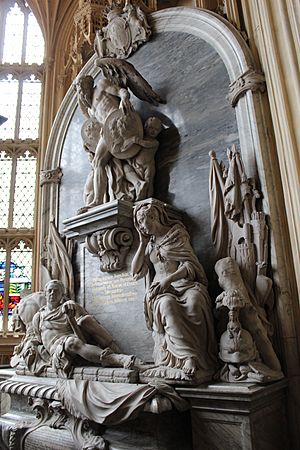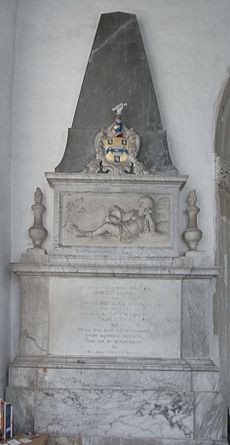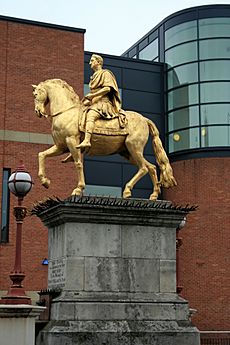Peter Scheemakers facts for kids
Quick facts for kids
Peter Scheemakers
|
|
|---|---|
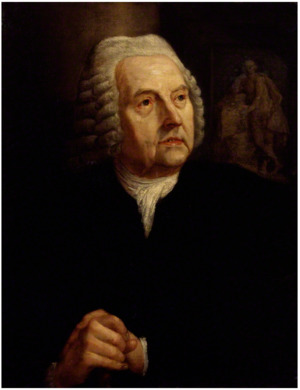
Portrait of Scheemakers by Andreas Bernardus de Quertenmont
|
|
| Born | 1691, Antwerp |
| Died | 12 September 1781 (aged 90), Antwerp |
| Nationality | Flemish |
| Known for | Sculpture |
|
Notable work
|
Tomb monuments and garden statuary |
| Patron(s) | William Kent |
Peter Scheemakers (born 1691, died 1781) was a famous sculptor from Flanders. He spent most of his life working in London, England. His sculptures, made in a classical style, greatly influenced how modern sculpture developed in England.
Scheemakers is especially known for creating the memorial to William Shakespeare in Westminster Abbey. This important artwork was put up in 1740 in a special area called Poets' Corner. He also made a memorial for John Dryden in the same church.
Contents
Peter Scheemakers: A Famous Sculptor
Early Life and Training
Peter Scheemakers was born in Antwerp, a city in what is now Belgium. He was baptised (given a Christian name) on January 10, 1691. His father, also named Peter Scheemaekers, was a sculptor too. Peter was one of several children.
He followed in his father's footsteps and became a sculptor. For two years, from 1718 to 1720, he worked with his older brother, Henry Scheemakers, in Copenhagen, Denmark. They worked for the court sculptor Johann Adam Sturmberg. It is said that in 1715, Peter walked all the way from Copenhagen to Rome. This was a very long journey, over 1,500 kilometers! In Rome, he studied different styles of sculpture, including classical and baroque art.
Starting Work in London
Around 1720, Scheemakers moved to London. There, he became friends with another sculptor from Flanders, Laurent Delvaux. Delvaux had arrived in London a few years earlier.
In 1721, a sculptor named Pierre-Denis Plumier came to London. He started working on a large monument for John Sheffield, 1st Duke of Buckingham and Normanby. Sadly, Plumier died a few months later. Peter Scheemakers and Laurent Delvaux finished the monument together. It was placed in Westminster Abbey in 1722. Peter's brother, Henry Scheemakers, also moved to London by 1726.
In 1723, Peter and Delvaux officially became partners. They opened a workshop in Millbank, London. They created many serious, classical monuments and garden statues. To save money for a trip to Rome, they sold their artworks in 1728. Then, both sculptors traveled to Rome to study ancient and new masterpieces. Delvaux stayed in Rome longer, but Scheemakers returned to England in 1730 after two years.
Building a Career in London
When Peter Scheemakers came back to London, he reopened his workshop. His classical sculptures became very popular. Rich landowners and business people loved his work. He moved his workshop a couple more times. First, to Old Palace Yard in 1736, and then to Vine Street in 1740. He stayed there until he retired in 1771.
Scheemakers worked with other artists, like Francis Bird. He also taught young sculptors, including Charles Cope Trubshaw and Thomas Banks. In 1750, Joseph Nollekens became his apprentice. Nollekens later became a famous sculptor himself. Peter Scheemakers did not have any children of his own. His nephew, Thomas Scheemakers, who was also a sculptor, took over his workshop when Peter retired.
Later Years and Legacy
Peter Scheemakers retired in 1771 when he was 80 years old. His wife, Barbara, had passed away a few years earlier. He decided to move back to his hometown of Antwerp to live with his brother and sister. He died there in September 1781. He was buried in the same church where he had been baptised over 90 years before.
Peter Scheemakers left behind a will, which is a legal document about what happens to his belongings after he dies. He gave money to his workers and some family members. His nephew, Thomas Scheemakers, who took over his workshop, received a part of his estate.
Amazing Sculptures and Monuments
Peter Scheemakers created many artworks throughout his life. He made monuments, figures, busts (sculptures of heads and shoulders), and tombs.
Works in Westminster Abbey
He made 16 works just for Westminster Abbey, and 15 of them are still there today!
- Monument to William Shakespeare (1740): This is Peter Scheemakers' most famous work. It was designed by William Kent.
- Monument to John Sheffield, 1st Duke of Buckingham and Normanby (1722): Scheemakers and Laurent Delvaux finished this after another sculptor died.
- Monument to Dr Hugh Chamberlen (1728): Another work made with Laurent Delvaux.
- Monument to Admiral Sir Charles Wager
- Monument to Vice-Admiral Watson
- Monument to Lt. General Percy Kirke
- Monument to George Howe, 3rd Viscount Howe
- Monument to General Monck: Also designed by William Kent.
- Monument to Sir Henry Belasyse
- Bust of John Dryden (1720)
- Bust of Dr Richard Mead (1754)
- Memorial to Thomas Jordan (1736)
- Memorial to Lord Aubrey Beauclerk (1741)
- Memorial to Admiral Sir John Balchen (1744)
- Memorial to William Horneck
- Tomb of Dr John Woodward (died 1728)
- Tomb of Magdalen Walsh (died 1747): This tomb was moved in 2008.
Other Sculptures in England
Scheemakers created many other important works across England:
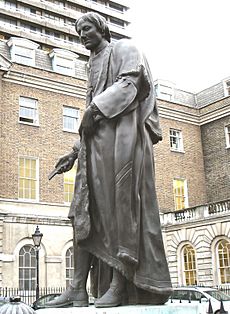
- Monument to Sir Michael Warton (around 1730) in Beverley Minster.
- Statue of Thomas Guy (1734) at Guy's Hospital, London.
- Equestrian (on horseback) Statue of William III (1734) in Kingston-upon-Hull.
- Statue of Sir John Barnard (1737) for Royal Exchange, London.
- Statue of King Edward VI (1737) in St Thomas's Hospital, London.
- Bust of William Harvey (1739) in the Royal College of Physicians.
- Tomb of Samuel Rolle (1746) in Chittlehampton Parish Church, Devon.
- Bust of King Edward (1747) at King Edward's School, Birmingham.
- Statuary group of Cain killing Abel (around 1760) at Chiswick House, London.
- Bust of James Jurin (1766) in Trinity College, Cambridge.
- Tomb of Philip Yorke, 1st Earl of Hardwicke (1766) in Wimpole, Cambridgeshire.
He also made memorials for the 1st and 2nd Dukes of Ancaster at Edenham, Lincolnshire, and for Lord Chancellor Hardwicke at Wimpole, Cambridgeshire.
Sculptures in Ireland
Peter Scheemakers also created artworks for Ireland:
- In 1743, Mary Coghill built the church of Clonturk (now Drumcondra Church) in memory of her brother Marmaduke Coghill. She placed a statue of him by Scheemakers there.
- He also sculpted fourteen busts for the Long Room of the Trinity College Library in Dublin. These included busts of famous people like James Ussher, William Shakespeare, John Milton, John Locke, Cicero, Homer, Aristotle, and Socrates.
Peter Scheemakers on Banknotes
Did you know that Peter Scheemakers' work was once on money? Between 1970 and 1993, an image of his Shakespeare statue appeared on the back of the £20 notes issued by the Bank of England. Next to the statue was a picture of the famous balcony scene from Shakespeare's play Romeo and Juliet.
See also



